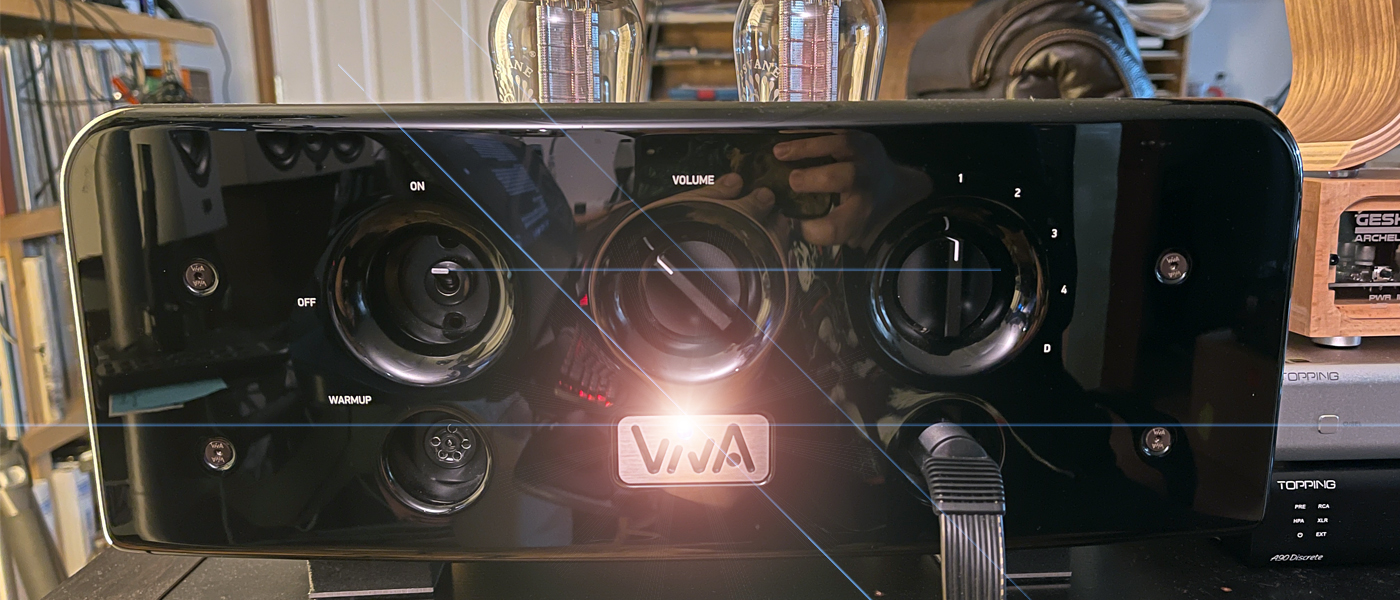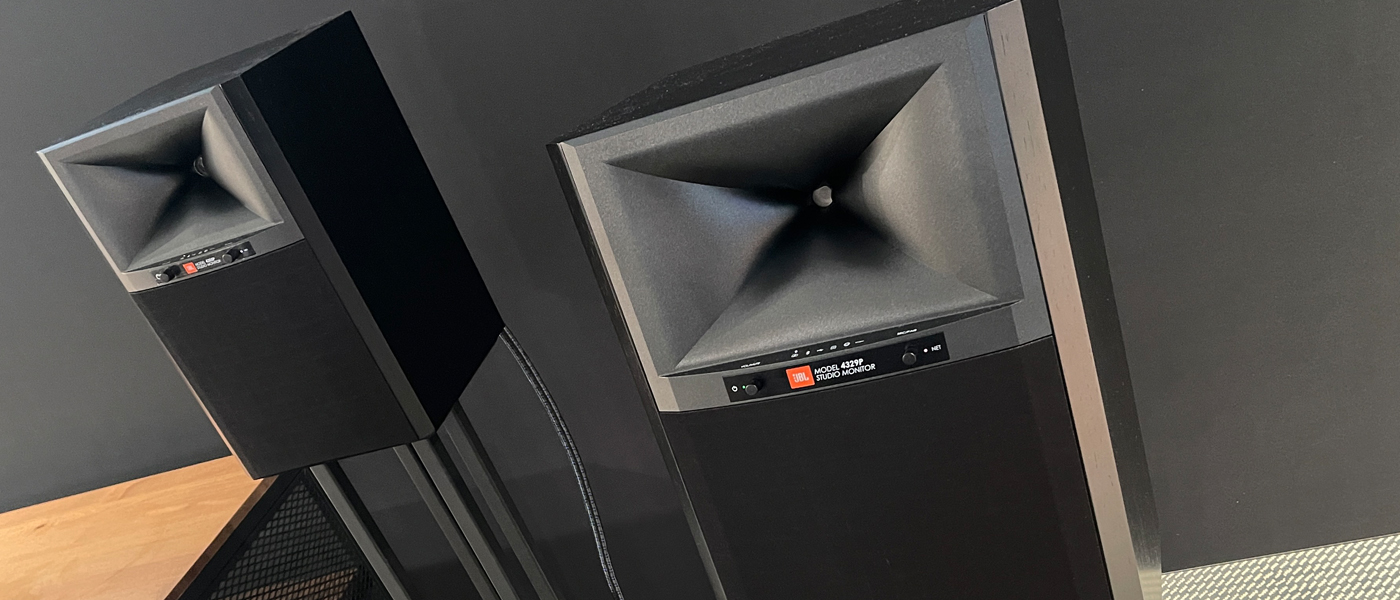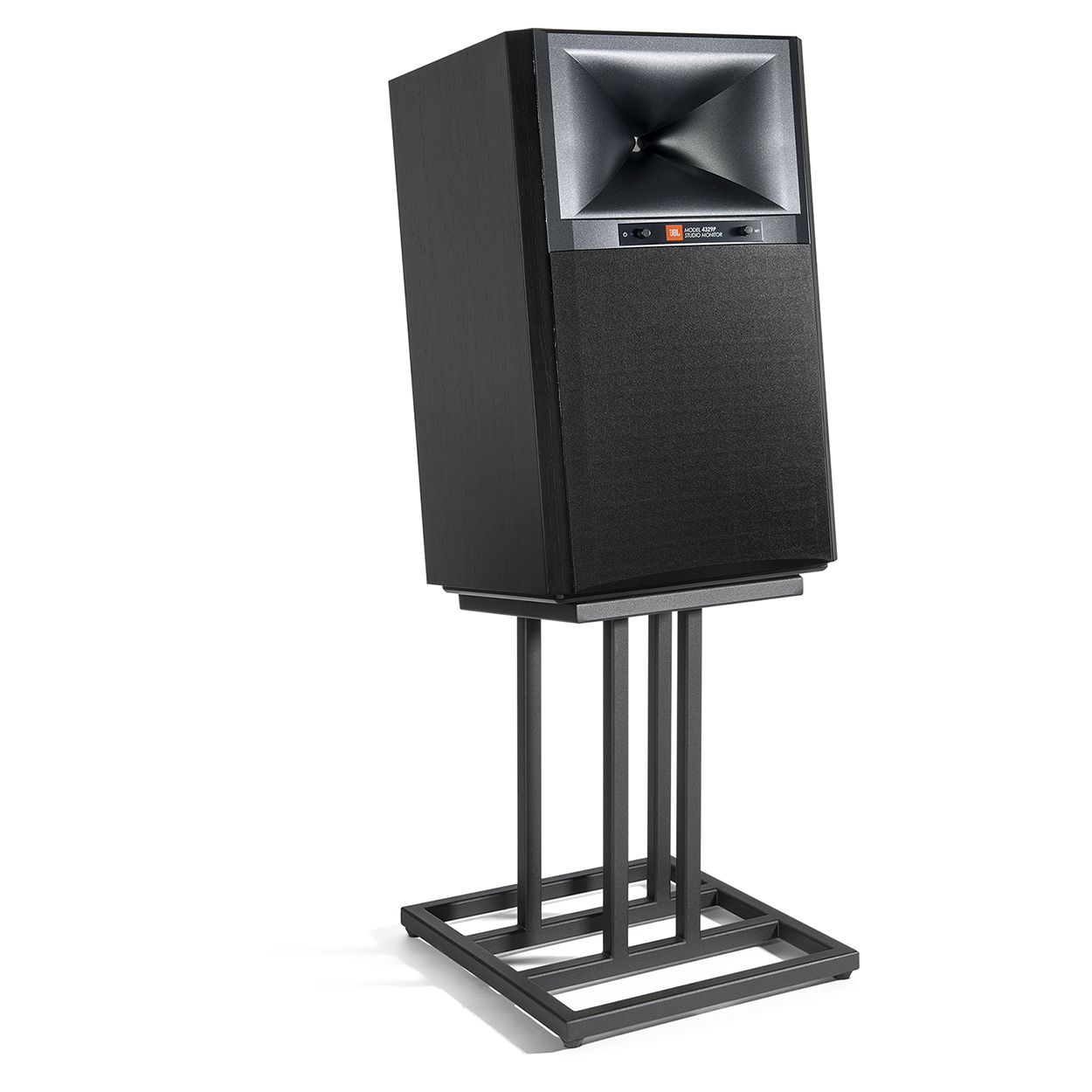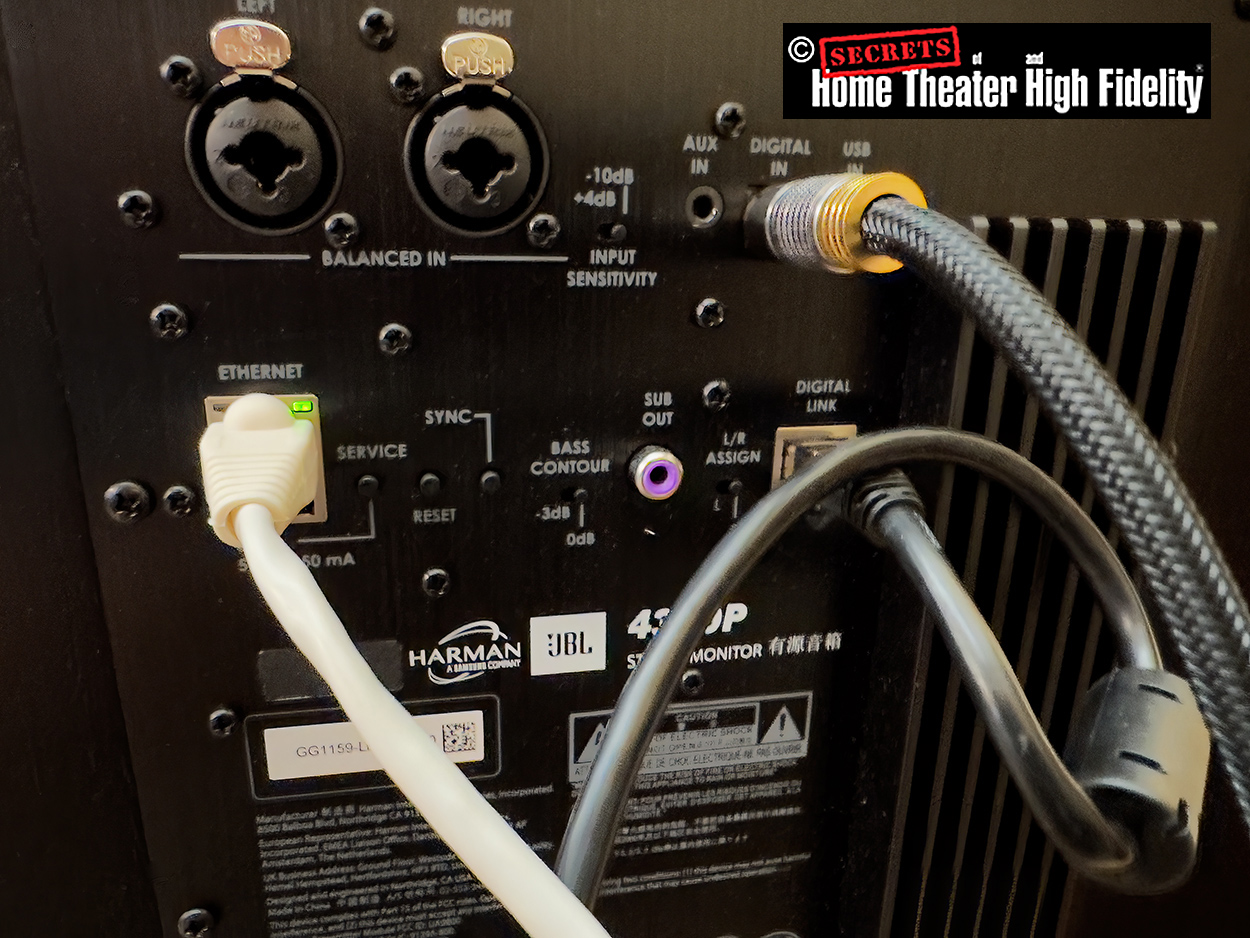To my great surprise, the JBL 4329P Studio Monitor would be welcome in any audiophile’s home or listening room. Deep bass without adding a subwoofer, smooth highs, and extended dynamic range add up to a superb audio experience.
JBL 4329P Studio Monitor Speakers Highlights
- Top-notch build quality.
- Powerful built-in dual amplifiers deliver 300 watts per speaker.
- A variety of digital and analog inputs.
- Wi-Fi, Bluetooth, Chromecast, and Airplay connectivity.
- Excellent dynamic range, and low- and high-frequency extension.
- Very strong center fill and imaging capabilities, among the best I have heard.
- Lacks RCA unbalanced inputs.
- Linking cord between speakers could be too short for some installations.
- Lacks HDMI for use with a TV.
The JBL 4329P Studio Monitors are the latest in a long line of innovative and popular products from JBL. The company is more than 75 years old and is a household name even outside of the audiophile world. Their speakers powered the Woodstock Music Festival, and in 1970, The Grateful Dead used 586 JBL speakers to create their live performances. JBL speakers are often the preferred monitors at recording studios all over the world.
The company has made many gains outside of professional audio, and it likely began when pro musicians and engineers wanted to replicate the sound they were hearing in their studios at home.
In the 70s, the JBL L100 was a runaway hit, largely because of its sound, and the striking die-cut foam and bright colors that made up its grille. JBL recently reintroduced an upgraded L100 and it’s popular all over again.
I first heard JBLs when I visited an uncle who lived in Illinois way back in the 60s. For a young boy like me who loved music, he was the only other family member who was interested in good sound reproduction. He had JBL floor-standing speakers on either side of a lovely low walnut cabinet. Inside that cabinet, he had a Sherwood receiver, a Thorens turntable, and a Viking reel-to-reel deck which I remembered because the tape heads were at the top of the tape deck instead of the bottom. We listened to a lot of Sinatra and Brubeck. It was exhilarating. The visit demonstrated to me that there was more to home audio than a Zenith portable which is what we had at home.
Over the years my musical taste settled into mostly classical, jazz, and a variety of acoustic music. I had always favored what audiophiles used to call ‘East Coast Sound’ which was more laid back and reproduced the music I liked accurately. In the past, that sound was exemplified by speakers from companies like AR, KLH, Infinity, Magnepan, and others. The sound was based on live music, often classical, and deep bass often came from the AR-introduced acoustic suspension design.
That ‘sound’ as opposed to ‘West Coast Sound’, mainly in JBL products, with horn tweeters, very deep bass with bass reflex woofers, and wide dynamic range. Great speakers for rock and roll, electronica, and anything that needed a ‘punch’.
Now, I think the two schools are blending, because dynamic range is seen as a basic in speaker design, and wide frequency response, as exemplified by the “East Coast Sound,” is seen as a given for all speaker designs, and clean bass response is seen as important to all kinds of music reproduction and of course in films.
What I learned in this review was that horn designs have improved greatly, moving beyond the kind of PA sound I associated with them, and they have become excellent music transducers.
Type:
Bass-reflex Loudspeaker System with Built-in Amplification, DSP, and Wireless Connectivity
Low-Frequency Drivers:
JW200P-4, 8-inch (200mm) Pure-pulp Black Paper Cone Woofers with Cast-frames
High Frequency Drivers:
2409H, 1-inch (25mm) Annular Ring, Teonex® Diaphragm Compression Drivers with Advanced HDI™ Geometry Horns
Amplifier Power:
600W Class D System Power, 300W RMS per Speaker (50W per HF Compression Driver + 250W per LF Woofer)
Audio Resolution:
Up to 24-bit, 192 kHz (Digital Link connection between speakers)
Audio Resolution:
Up to 24-bit, 96 kHz (Wireless connection between speakers)
Frequency Response:
28 Hz – 25 kHz (-6 dB)
Crossover Frequency:
1,675 Hz
Dispersion:
90° Horizontal x 60° Vertical (2kHz to 15kHz)
Sound Controls:
Front Panel
Wireless Inputs:
Wi-Fi streaming, Bluetooth 5.3
Wired Inputs (Analog):
XLR/¼” Combo and 3.5mm stereo
Wired Inputs (Digital):
Asynchronous USB-B and Toslink/Optical
Supported Digital Audio Sample Rates: (PCM 2CH):
Streaming & Local Media – 32kHz/44.1kHz/48kHz/88.2kHz/96kHz/176.4kHz/192kHz SPDIF – Up to 192kHz USB-B – PCM 2-channel, up to 192kHz Bluetooth – Up to 48kHz, aptX Adaptive up to 96kHz
Music Formats Supported (Local Media):
AAC / AIFF / ALAC / DSD64 (to PCM) / FLAC / MP3 / MP4 / MQA / OGG / WAV / WMA
Subwoofer Output:
Autosensing w/ Auto-engage of 80Hz High Pass Filter
Remote Control Type:
BTLE Wireless
Bluetooth Audio Version:
5.3
Bluetooth Audio Profiles:
SPP (Serial Port Profile), A2DP (Advanced Audio Distribution Profile), AVRCP (Audio/Video Remote Control Profile)
Enclosure:
Bass-reflex Design with Dual Front-facing Ports, ¾” MDF Finished in Satin Walnut, White Aspen, or Black Walnut Furniture-Grade Wood Veneer
Grille:
Dark Blue (with Walnut Cabinet), White (with White Aspen available in 4th quarter, 2023), or Black (with Black Cabinet) Acoustically Transparent Cloth Grille
Net Speaker Dimensions with grille:
20.3” H x 12.6” W x 12.7” D (515.5mm x 320mm x 322.4mm)
Net Speaker Weight:
Primary – 34.5 lbs. (15.7kg), Secondary – 34.3 lbs. (15.6kg)
AC Input Voltage:
100 – 240 VAC (+/-10%), 50/60Hz
MSRP:
$4500.00
Website:
Company:
SECRETS Tags:
JBL, powered speakers, streaming speakers, bookshelf speakers, streaming speakers reviews, bookshelf speakers reviews
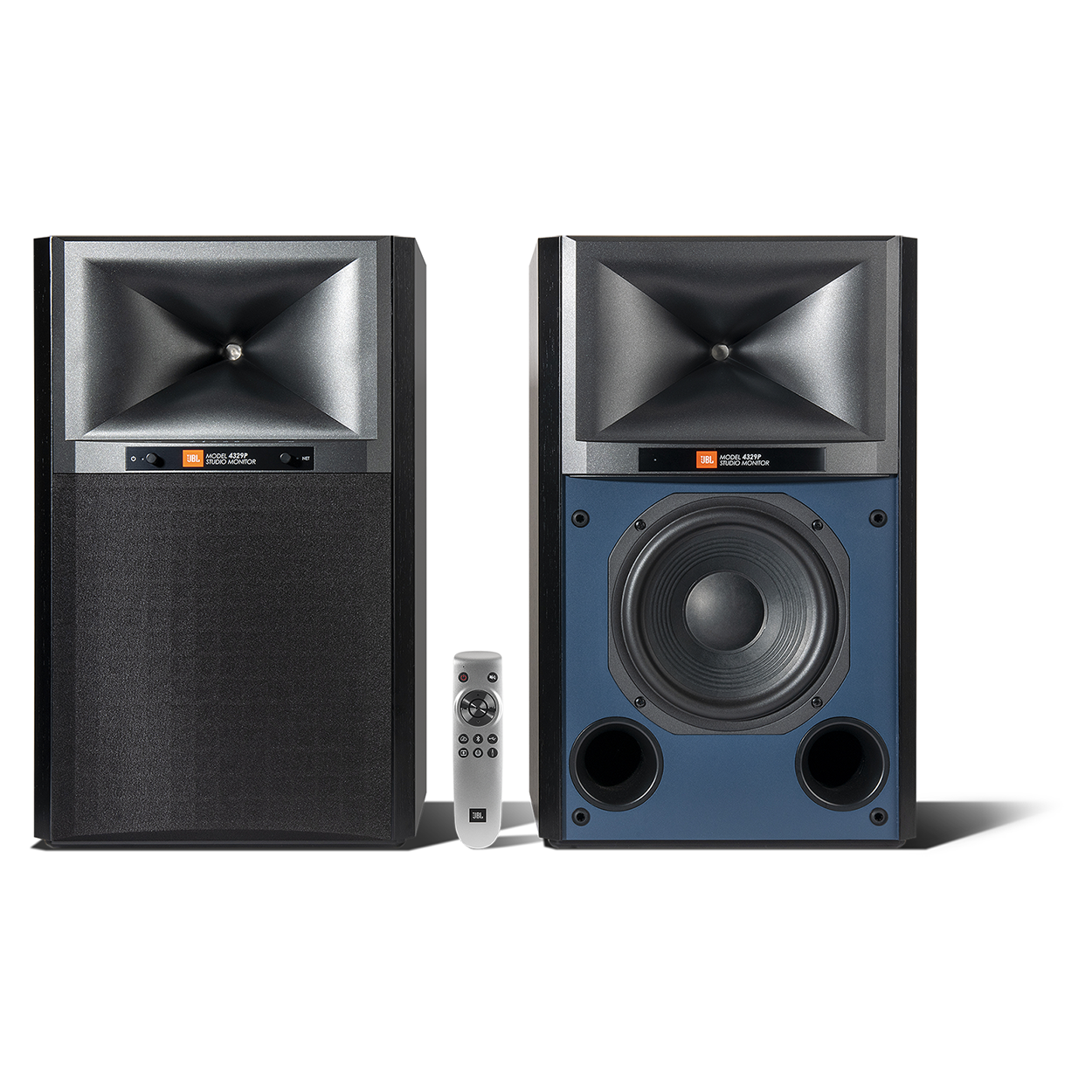
The JBL 4329P Studio Monitors are full-featured and easy to set up. Only one of the speakers has inputs and outputs, and it should be placed closest to your source components. There’s a handy back panel switch that lets you assign if that speaker is the left or right channel. Both speakers need to be plugged into an AC outlet, as they both contain amplifiers. 250 watts drive the 8 “woofer in each speaker, and 50 watts drive the 1” horn compression driver.
Digital signal processing optimizes the crossover and assists with power handling.
I’d call the JBL 4329P system a retro design, and it looks stunning, available in Black Walnut, Natural Walnut, or White Aspen in the 4th quarter of this year. The design recalls iconic JBL speakers from the past. Here you can see the blue finish with the grille removed.
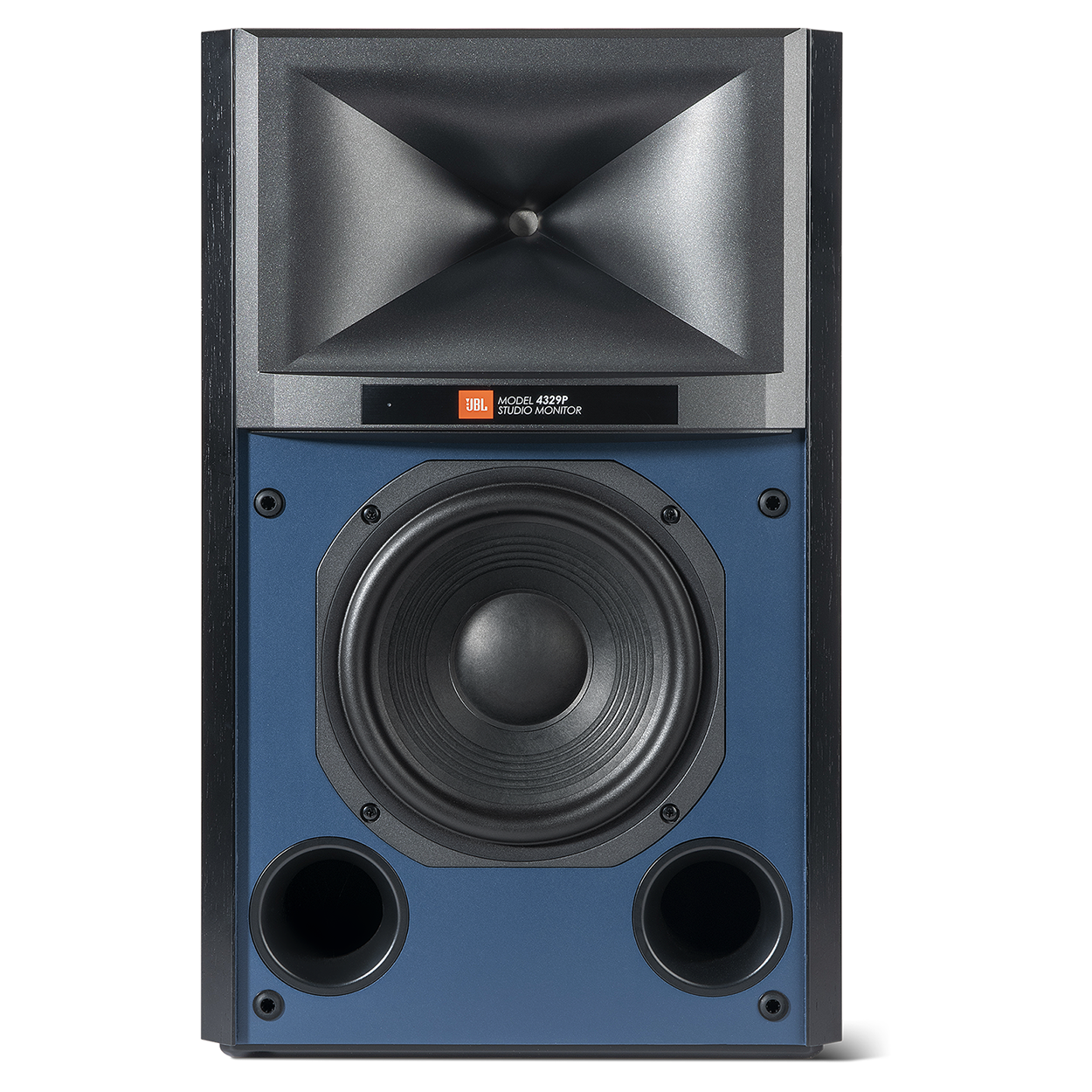
You can attach any source component you like to the JBLs, using USB, optical, XLR, or a 3.5mm stereo plug. It’s missing a standard pair of unbalanced RCA inputs, which I find an odd choice.
The JBL 4329P can stream audio over Wi-Fi using Chromecast, Airplay 2 from Apple, and Bluetooth aptX Adaptive. Its built-in DAC can accommodate 24/192 signals, and all the expected high-res formats are supported, including MQA.
The 4329P Studio Monitors are now Roon Ready, although my review sample did not have that feature yet. The speaker can serve as a Roon Endpoint, which I consider a major plus.
Silly me, I was expecting a sort of good-sized bookshelf system, but when the UPS man dropped them off, there were two large boxes. One was a 90-pound box with two speakers and about a 50-pound box with two stands for the speakers. I was glad I had a rolling cart to get these babies off the front porch.
Secrets Sponsor
Everything was well-packed and protected. The stands (an optional extra) were assembled, so happily, no screwdrivers or Allen wrenches were needed.
Each speaker weighs about 35 pounds, (remember there are 300-watt amps in each) so I placed each speaker at the end of my low equipment cabinet using the supplied JBL stands. The speakers can be wired with the included 10-foot CAT5e cable or connected by Wi-Fi. I opted for the wired option because there was a slight frequency response advantage. JBL says you can use any CAT5 or above cable up to 20 feet in length and get 192kHz / 32-bit between the speakers. Using the wireless connection will get you 96kHz / 24-bit which really is more than adequate.
In my setup, the included 10-foot cable was just enough to make the connection.
There is an included wireless remote. It’s a basic affair and my sample did not include batteries. JBL assures me that retail versions of the speaker do include batteries for the remote.
The remote offers power on, input selection, volume control, and mute. The remote is not illuminated.
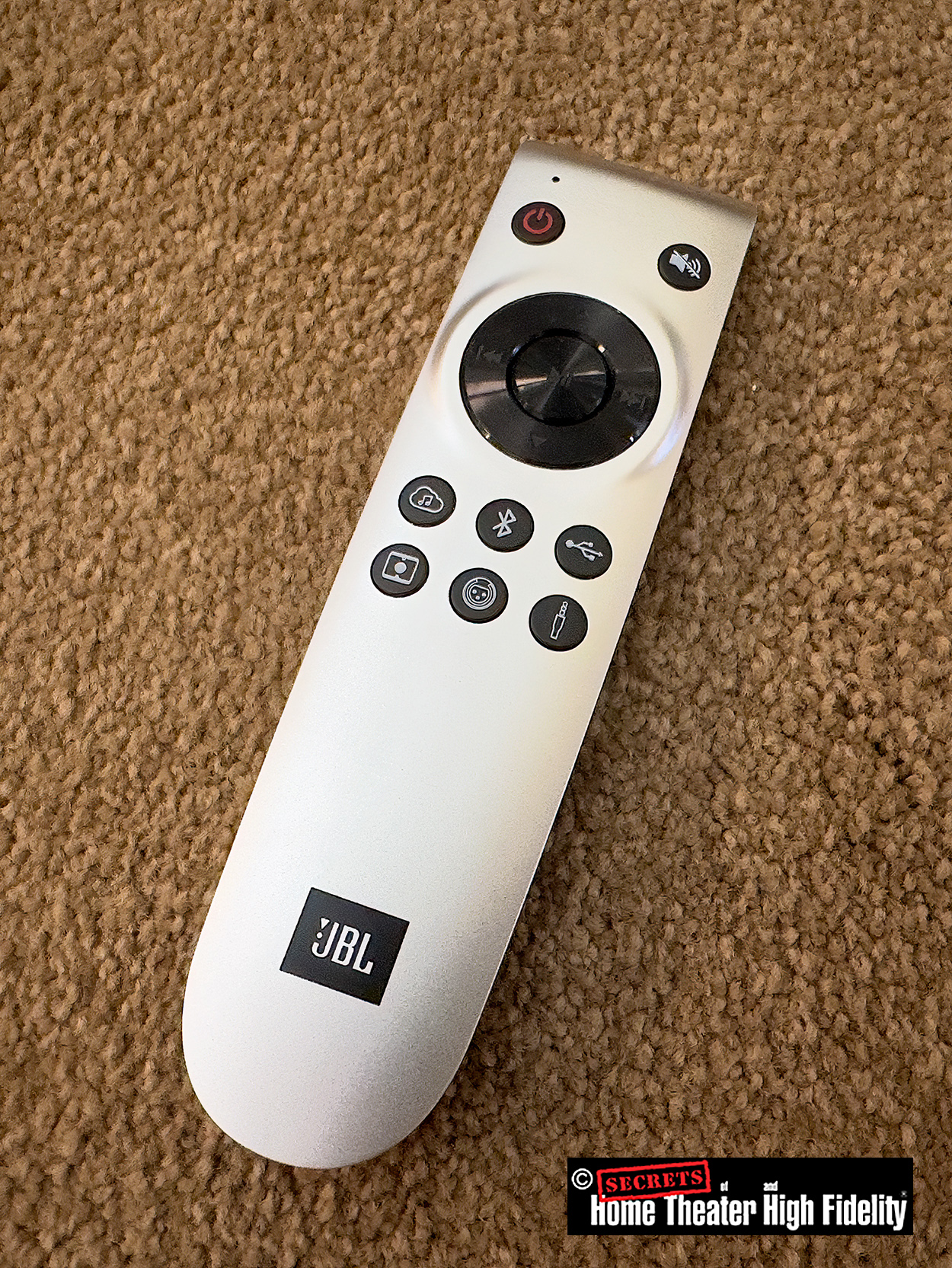
There are small white LEDs on the main speaker that indicate if the power is on, and which input is selected. When the speakers are on standby, the LED is red.
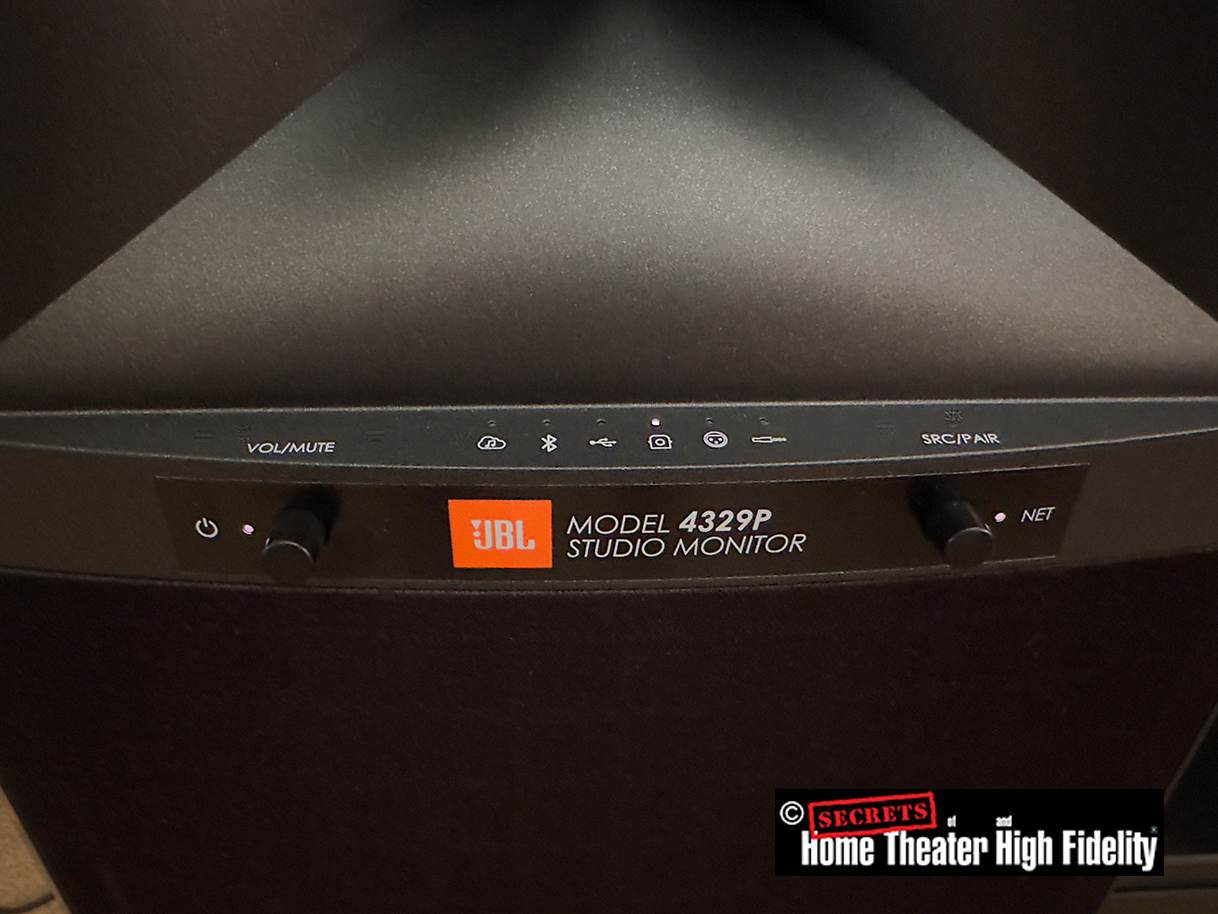
For my listening tests, I attached a Bluesound Node 2i streamer which is an endpoint for my Roon system, so I could play a wide variety of music at high bitrates. The Node 2i was hooked to my gigabit ethernet network and I connected that device via an optical cable to the JBLs. I also tried Airplay and Bluetooth and confirmed they worked, but I think Roon is the better sound quality choice, which is why I hooked the Bluesound up which delivered Roon to the speakers. As mentioned above, shipping versions of the speakers are now Roon Certified.
I also listened to high-resolution tracks streamed from Tidal through the Node 2i. As mentioned, JBL kindly sent a pair of their JS-80 Speaker Stands. They are solid, and tilt the speakers back slightly, aiming the drivers at ear level.
I didn’t have much in the way of preconceived notions about how the JBL system would sound. I haven’t heard horn speakers in many years and thought the mid to high frequencies would be inferior to my other speakers in the house from Ohm, KEF, and Focal. That wasn’t the case. JBL drivers have come a long way over the years, and they sounded smooth and extended. I moved some of my highly regarded ‘East Coast’ speakers into my living room and switched back and forth and did not find the JBLs wanting in any way. The JBLs lacked any form of equalization, something I missed because my other speakers had the virtue of Dirac or ARC but that wasn’t an option here. I’d like to see JBL offer some tuning options for room matching. There is a switch to adjust the low end for corner placement of the speakers.
Secrets Sponsor
Neither speaker was in a corner, and the low end surprised in a good way. While the JBL has a subwoofer output, the 8” woofer was doing just great. I played a variety of music with low percussion and organ music and never found the system sounding bass shy. JBL has done a great job matching the woofers and amplifiers with whatever digital magic they are using to get coherent, deep bass out of these speakers.
I listened to the 4329P speakers in 2 different rooms, my large living room, adjacent to an open kitchen, and in my home theater, a smaller square room. Both rooms are carpeted.
Another comment I’ll make before talking about individual music selections is the excellence of the imaging of these speakers. On most recordings, the sound seemed to come from a contiguous space from left to right. It was a very precise stereo image, and it included front-to-back depth on the best recordings. It surpassed all the speakers I had in-house, including my home theater system with a dedicated center channel. I’m impressed.

Vaughan Williams Oboe Concerto “Halle”
I started my listening marathon with the Vaughan Williams Oboe Concerto in A minor with the Hallé Orchestra conducted by Sir Marc Elder. This is a beautiful recording of one of the best Vaughan Williams works. Oboist Stéphane Rancourt’s oboe solo is sublime, and the JBLs capture the sound of his oboe firmly in virtual space between the left and right speaker. The strings sound ‘live’ and far better than I imagined a horn driver could sound. The low bass from the strings is not strained in any way, confirming my view that no subwoofer is needed with these speakers. I listened to the music from my Roon server from a 44.1/24-bit FLAC.
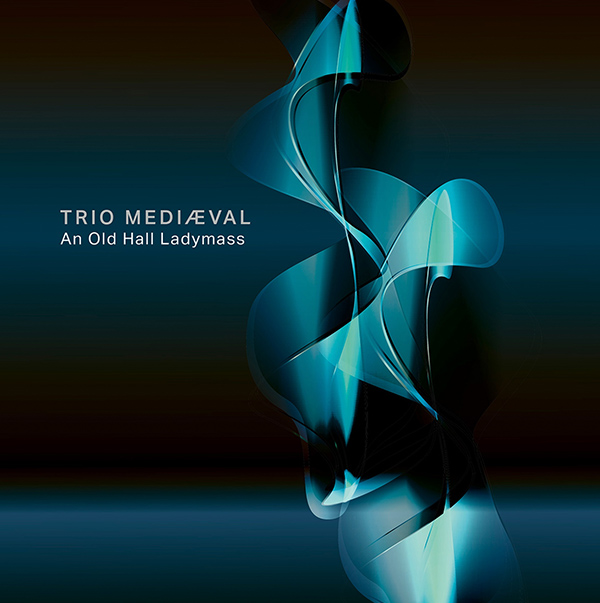
Trio Medieval “An Old Hall Ladymass”
Another treat was a new 2L recording from the Trio Medieval. I listened to several tracks from this 176.4/24-bit FLAC in stereo only, although the full recording supports surround channels and even Atmos. All the singers and instruments were locked in place and the JBLs nicely reproduced the sound of the recording venue.
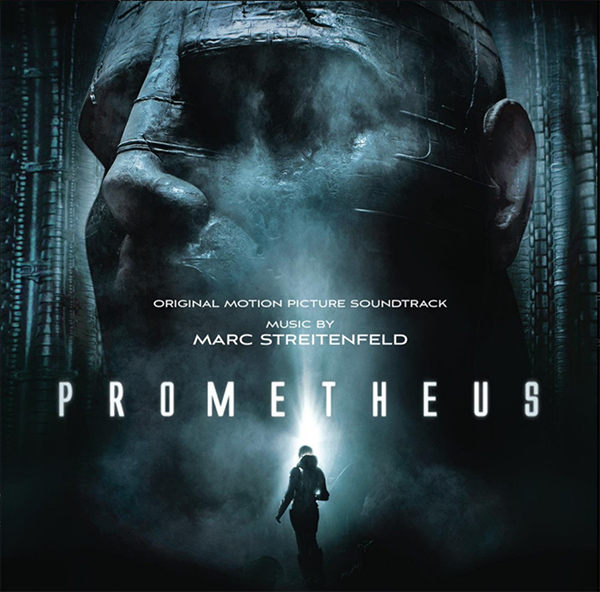
Soundtrack “Prometheus”
Prometheus Soundtrack: Composer Marc Streitenfeld composed an epic score, with orchestra, and electronics. There’s a choir, and some very deep bass, which was no challenge for the JBL 4329P speakers. AAC/257kbps
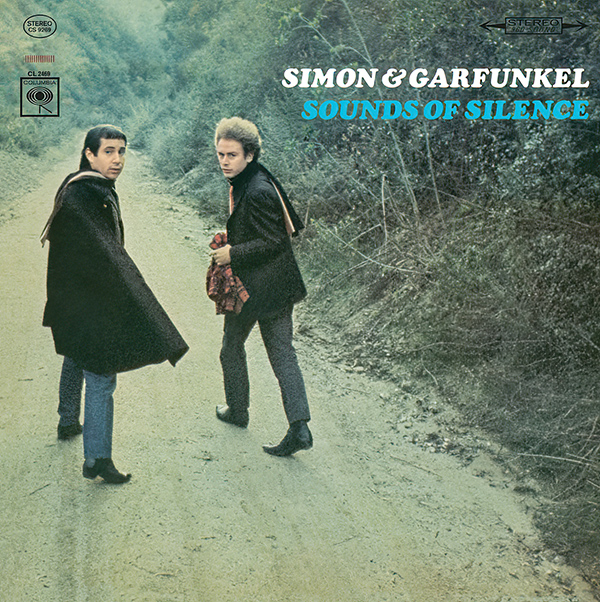
Simon and Garfunkel “Sounds of Silence”
Simon and Garfunkel – April, She Will Come: A lovely track from The Sounds of Silence. It’s an intimate piece, and the JBLs nicely capture the voices with realism and dynamics. This version is a 44/16 FLAC.

Robyn Hitchcock “Spooked”
Spooked – Robyn Hitchcock: Two voices, two guitars. The track “If You Know Time” has standout imaging, a great rendering of the singers and the guitars. 44/16 FLAC
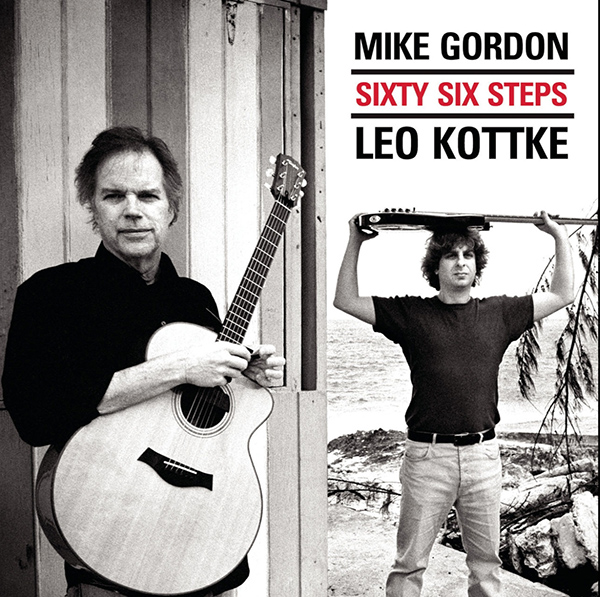
Leo Kottke and Mike Gordon “Sixty-Six Steps”
Sixty-Six Steps: Leo Kottke and Mike Gordon: Like all the tracks on this album, Cherry County sounds realistic, and the JBLs nail the positions of the guitars. The higher register notes sparkle, and the bass is tight. 44/16 FLAC
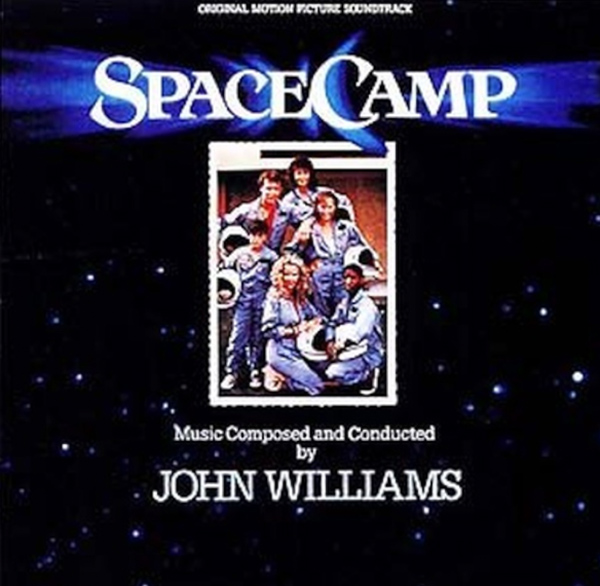
Space Camp “John Williams”
Space Camp – John Williams: Not much of a movie, hampered further by the Challenger blowing up just around release time. Nevertheless, a rousing score by John Williams. On the JBL 4329Ps, this 44/16 FLAC gives a really nice front-to-back image when the full orchestra plays. The bass is solid, and the strings sound like…well…strings.
At $4500 dollars these aren’t inexpensive speakers, and if you add the JS-80 speaker stands it’s another $400. Still, the build quality of the speakers is exceptional, along with the sound. Audiophiles with a collection of high-quality amps wanting to just get new speakers won’t find this product attractive, but if you are adding a system in another room where you want to do some serious listening without setup hassles, the JBL 4329P powered speakers can’t be beaten. Or if you have an older system and have the itch to update to something more modern, these JBL powered speakers are worthy of your serious consideration. They are directly competitive with similar-priced systems, powered or not, but if you are using unpowered speakers, you’ll have to add the cost of high-quality, high-power amps to your calculations when you compare.
- First, of course, the sound. It’s very good, with tremendous dynamics, deep bass, and sparkling highs.
- Imaging is as good as I’ve heard from any high-end speakers in my rooms.
- Left and right speakers can be cabled together, or it can be done wirelessly.
- Needs only a source (direct or streaming) to be a full high-end system.
- Very well built. Quality wood exterior, and high-quality parts.
- The cabinet is inert, a tribute to the care of the design.
- Would like some way to adjust frequency response for room matching.
- HDMI port would be nice for use with a display.
- Speaker link cable may be too short for some installations.
- Lacks unbalanced RCA inputs, even though that connection has universal acceptance.
These JBL 4329P speakers were a tremendous and positive surprise. As someone who hasn’t heard JBLs in a good listing environment for years, the sound was faultless. The horn compression drivers were the biggest leap from what I expected. In my past sessions with horn drivers, I recalled hearing a lot of glare, forward midrange, and subdued highs. I’m not sure when JBL tackled these issues, but these speakers are clean, with tremendous dynamic range. When I pushed them above 90db there were no signs of strain. I think there is a benefit to matching an amp to the speakers, and the JBL engineers succeeded nicely here. Although I don’t have any place in my home to house these speakers, I kept dreaming about adding another room.


